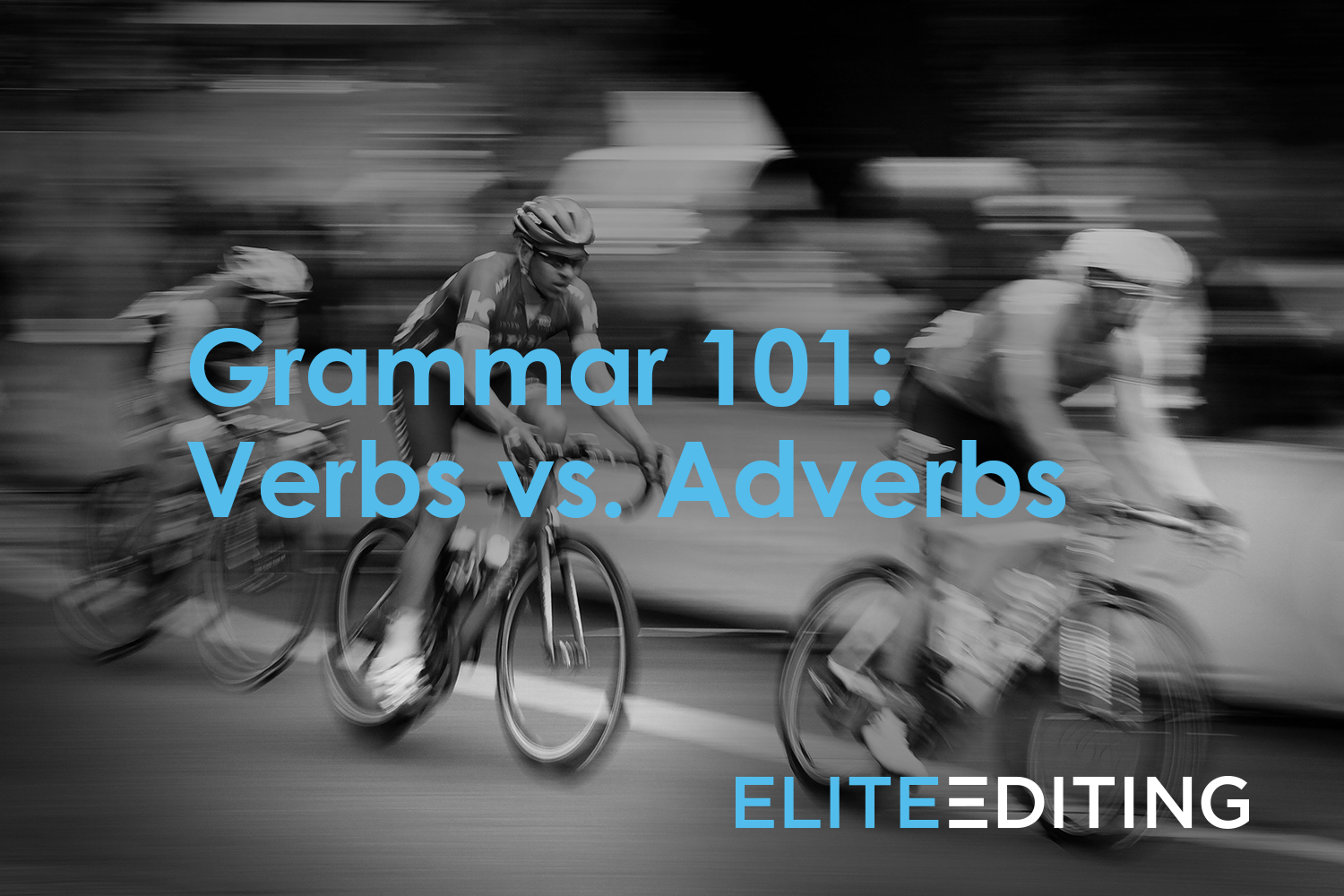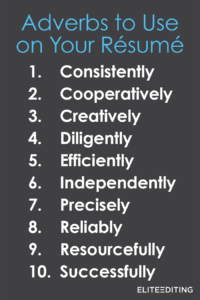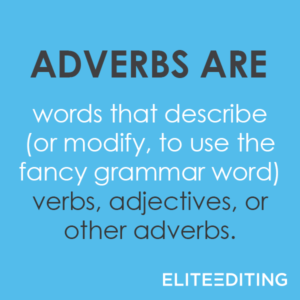
What are verbs and adverbs? Simple! An adverb is a verb that has gone into advertising.
Okay, that was a joke. But in fact, despite the similarity of their names, verbs and adverbs have two different jobs. The main difference between verbs vs. adverbs is that verbs are action words, and adverbs are description words. Verbs state the action performed by a noun, while adverbs provide more information about how that action is performed.
All right, it’s a little more complicated than that, so let’s get into the nitty gritty and answer these questions: What are adverbs? What are verbs? What are action verbs? What is a main verb? Are there different types of verbs? Different types of adverbs? If the next match in the thunderdome were verbs vs. adverbs, who would emerge victorious?
That last one is tricky. Fight is a verb, and so are destroy and win, but if you want to fight fiercely so that you can utterly destroy your opponent and bravely win, you really need adverbs. So in the smackdown of verbs vs. adverbs, there’s no clear winner. Team them up, however, and they’re undeniably entirely unstoppable.
What Are Adverbs?
If you’re wondering, What are adverbs?, it’s simple. Adverbs are words that describe (or modify, to use the fancy grammar word) verbs, adjectives, or other adverbs. Adverbs give us more information about how something is being done or the degree to which something is true. Adverbs often end with -ly, but there are common adverbs that don’t end in -ly (such as very, fast, well, and more). There are also words that end in -ly but aren’t adverbs (such as ally, family, and lovely).
Types of Adverbs
There are several types of adverbs. We can sort adverbs into loose categories based on what kind of information they’re giving us. Adverbs can tell us more about
- how something is being done,
- when it’s happening,
- how often it’s happening,
- where it’s happening, and
- the degree to which something is true.
Let’s look more closely at each of these types of adverbs.
Manner
Adverbs of manner describe how an action is being done.
- Gisela swam gracefully.
- Peter carefully measured out the sugar.
- I spoke slowly and deliberately so my slightly deaf grandmother could understand.
Time
Adverbs of time describe when an action is being performed.
- Frank arrived late to his own wedding.
- I need that report immediately.
- The teacher is giving us a test tomorrow.
Frequency
Adverbs of frequency describe how often or at what interval an action is performed.
- Sarah regularly eats oatmeal for breakfast.
- I never smile at children.
- Xavier runs three miles daily.
Place
Adverbs of place show where something is happening.
- Martin looked everywhere for his baseball.
- Victor told his monster to walk toward him.
- I much prefer riding my bike downhill.
Degree
Adverbs of degree illustrate the intensity of an action.
- George strongly dislikes tennis.
- Wilbur loves Charlotte deeply.
- Mad Max fought fiercely.
You can use additional adverbs to further intensify your description.
- George really strongly dislikes tennis.
- Wilbur loves Charlotte very deeply.
- Mad Max fought surprisingly fiercely.
And remember that adverbs can be used to modify adjectives as well as verbs and other adverbs.
- George’s dislike of tennis is really strong.
- Wilbur’s love for Charlotte is truly deep.
- The alarmingly fierce fight between Mad Max and Blaster was completely riveting.
Warning! Be wary of drowning your sentences in adverbs. They’re like salt: a sprinkling adds flavor, but go overboard, and you’ll make the stew inedible—or your text unreadable.

What Are Verbs?
Like Schoolhouse Rock said, verbs are what’s happening. They are the only part of speech that can form a sentence all by themselves. One-word commands, because the subject, you, is implied, are a grammatically complete unit. Stop! Think! Celebrate!
Although most of us were taught in school that verbs are action words, that’s only partially true. Many verbs are action verbs, but there are two other types of verbs as well: helping verbs and linking verbs.
Types of Verbs
Verbs typically fall into three categories. The first category has two subcategories (explained below), so sometimes people divide verbs into four groups, but the number of categories is not really important. Schoolhouse Rock had it right. Three is a magic number:
1. Action verbs
– Transitive
– Intransitive
2. Helping verbs
3. Linking verbs
What Are Action Verbs?
Of all types of verbs, action verbs are the most powerful. Action verbs show the performance of an action. They are what the subject of a sentence does. You need them to make a complete sentence—because a subject plus a verb can make a complete thought.
- Georgi explained.
- Karen answered.
- Ilana dove.
- The tiger growled.
There are two types of action verb: transitive and intransitive.
Transitive Verbs
Transitive verbs take an object—that is, the subject does the action of a verb directly to something else (the direct object). What does Finn throw? He throws a football. Throw is a transitive verb.
- Georgi explained the complicated science of tachyon particles.
- Karen answers the phone with a cheerful “Ahoy there!”
- Penelope read every book in the library before she turned twelve.
Intransitive Verbs
Intransitive verbs, logically enough, don’t take an object. They might be qualified with an adverb or two. There might be a prepositional phrase following the verb. But you can never nap something directly. You can only nap for six hours or nap on the couch or nap soundly.
- Carl sleeps poorly.
- Norma sneezed three times in a row.
- David lied about being a dancer in Beyoncé’s most recent video.
Just to make life interesting, some verbs can be both transitive and intransitive, and they might have slightly different meanings.
- The Prince of Wales will succeed the current monarch when she dies.
Here, succeed means inherit the throne from, and it takes a direct object, so it’s transitive. But a more common use of succeed means something like triumph or achieve the desired result, and when we use it like that, it’s intransitive.
- Elon Musk succeeded at sending a sports car into space.
Other verbs can be both transitive and intransitive without their meaning changing much, if at all.
- Hannah sings a sad song.
Sing here is transitive because it takes a direct object. What is Hannah singing? She is singing a sad song. However, sing can also be intransitive because it doesn’t need a direct object to make sense.
- Hannah sings loudly in the shower.
What Are Helping Verbs?
The most common helping verbs are the various forms of be, do, and have, but the remaining helping verbs (forms of shall, will, may, can, and must) are equally useful. We use helping verbs to change the tense or the emphasis of a verb—or both.
- I am running faster than ever these days.
- I do run, but I prefer to walk when I’m wearing a tiara.
- I have run every day for nine years.
- I should run, but I am too lazy.
- I will run as soon as I finish this doughnut.
- May I run and join my friends now?
- I might run later, if I feel like it.
- I can run, but I can also dance, and dancing is more fun.
- I could run later, or I could binge-watch Stranger Things.
- I must run, or the zombies will catch up.
What Are Linking Verbs?
A linking verb shows a state of being rather than an action. Instead of the subject of a sentence doing something, a linking verb shows what the subject of a sentence is. The most common linking verbs are to be, to seem, and to become.
A linking verb is like an equal sign between the subject of a sentence and the predicate. It’s a way of saying, “Here’s more information about the subject!”
- Katherine seems great.
- Barbara is Diana’s mother-in-law.
- Andrew is becoming a really good singer.
Bonus Question! What Is a Main Verb?
After all that, you might be left still wondering, “What is a main verb?”
A main verb isn’t exactly a new category of verb because what makes a verb a main verb is its position and function in a sentence. The main verb is the operative verb in the central clause of a sentence or the verb that’s left once all the helping verbs are gone. For example, in this sentence, the main verb is sell.
If I move out, my mother can and will sell all my comic books.
Common Business Adverbs
The best business writing is often the simplest and most direct—the ideal is to use the fewest possible words to say exactly what you mean. This is even more important when you’re communicating with an international audience—colleagues who might not be completely comfortable with some of the finer nuances of English grammar and usage.
What does that mean for business adverbs?
The best business adverbs are the ones you don’t use. Instead of using a verb plus an adverb, look for a more precise verb. Or be specific rather than vague. Your writing will be stronger for it.
Instead of this: Our sales have grown quickly over the last six months.
Try this: Our sales have accelerated over the last six months.
Instead of this: Our number-one product sold well in the run up to Christmas.
Try this: Our number-one product sold three million units in December.
If nothing else, check out this list of some common adverbs that add nothing but length to your writing. You almost never need any of these, and they’ve been used (and overused and sometimes abused) to the point where they’ve lost their impact. Avoid them whenever possible: very, really, totally, actually, hopefully, suddenly, just, so, basically, apparently.
And here’s the grandmother of all adverbs to avoid: literally. People think that it adds weight and drama to their writing, but (1) it doesn’t, and (2) grammar nerds love to hate it, so if your boss is even mildly interested in good writing, chances are that she will read literally, and her head will figuratively explode, which could adversely affect your promotion prospects.
Even so, there are excellent ways to use adverbs in business writing to strengthen and clarify your intended message.
Common Business Adverbs of Time
Use adverbs to describe a sequence of events rather than relying on (potentially confusing) verb tenses to do that job.
Before we can schedule a stakeholder meeting, all departments must have finished their quarterly reports.
See how that could be confusing? Use adverbs instead to more clearly state the order of events.
First, all departments must finish their quarterly reports. Then, we can schedule a stakeholder meeting.
Common Mistakes with Business Adverbs
Some of the most common adverbs are the trickiest because they’re irregular. Good and well, for example, are frequently confused, as are bad and badly.
Wrong: He manages his team really good.
He handled his presentation bad.
Good and bad are adjectives, not adverbs.
Right: He manages his team really well.
He handled his presentation badly.
Other adverbs might be confusing because the adjective and adverb are the same word, like fast, late, and early.
The early bird gets the worm. (Here, early is an adjective describing bird.)
I get so much more work done when I arrive early. (Here, early is an adverb modifying arrive.)

Adverbs to Use on Your Résumé
There are also energetic and descriptive adverbs that will strengthen your résumé, but use them sparingly! If you’re choosy, the adverbs you do include will have greater impact.
Here are the top ten adverbs to use on your résumé. Some highlight your commitment, drive, and ambition while others emphasize your ability to work as part of a team.
- Consistently
- Cooperatively
- Creatively
- Diligently
- Efficiently
- Independently
- Precisely
- Reliably
- Resourcefully
- Successfully
We hope this article has helped clear up any confusion in the verbs vs. adverbs debate! If you encounter anyone else wondering, What are verbs and adverbs?, now you’ll be equipped to school them on the difference. And remember to check out our other posts on relevant grammar topics such as conjunctions and common comma mistakes, and brush up on your writing skills with our writing resources page.








